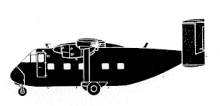Incident Overview
Date: Thursday 2 July 1970
Aircraft Type: Shorts SC.7 Skyvan 3-200
Owner/operator: Jetco Aviation International
Registration Number: N21CK
Location: Potomac River, WA –
ÿ United States of America
Phase of Flight: Approach
Status: Destroyed, written off
Casualties: Fatalities: 2 / Occupants: 2
Component Affected: Aircraft Control System (specifically, Elevator)Aircraft Control System (specifically, Elevator)
Investigating Agency: NTSBNTSB
Category: Accident

A Skyvan aircraft experienced a serious landing incident while approaching runway 15 in dense fog. The aircraft rapidly pitched downward, resulting in a significant impact with the water. The impact caused the aircraft to cartwheel onto the right wingtip and subsequently sank, being 1800 feet short of the runway. The incident was likely caused by a loss of effective elevator control due to improper cargo securing during a steep nosedown approach in poor visibility.A Skyvan aircraft experienced a serious landing incident while approaching runway 15 in dense fog. The aircraft rapidly pitched downward, resulting in a significant impact with the water. The impact caused the aircraft to cartwheel onto the right wingtip and subsequently sank, being 1800 feet short of the runway. The incident was likely caused by a loss of effective elevator control due to improper cargo securing during a steep nosedown approach in poor visibility.
Description
The Skyvan approached runway 15 in fog at 700-800 feet when about 0,5 mile out. With an already steep approach, the nose suddenly pitched down to 45 degrees. The aircraft struck the water, cartwheeled onto the right wingtip and sank in 12-15 feet deep water, 1800 feet short of the runway. PROBABLE CAUSE: “The loss of effective elevator control due to the forward shift of improperly secured cargo when the aircraft was placed in a steep nosedown attitude during a landing approach in reduced visibility conditions.”
Primary Cause
Loss of effective elevator control due to forward shift of improperly secured cargo during a steep nosedown approach in reduced visibility conditions.Loss of effective elevator control due to forward shift of improperly secured cargo during a steep nosedown approach in reduced visibility conditions.Share on:





